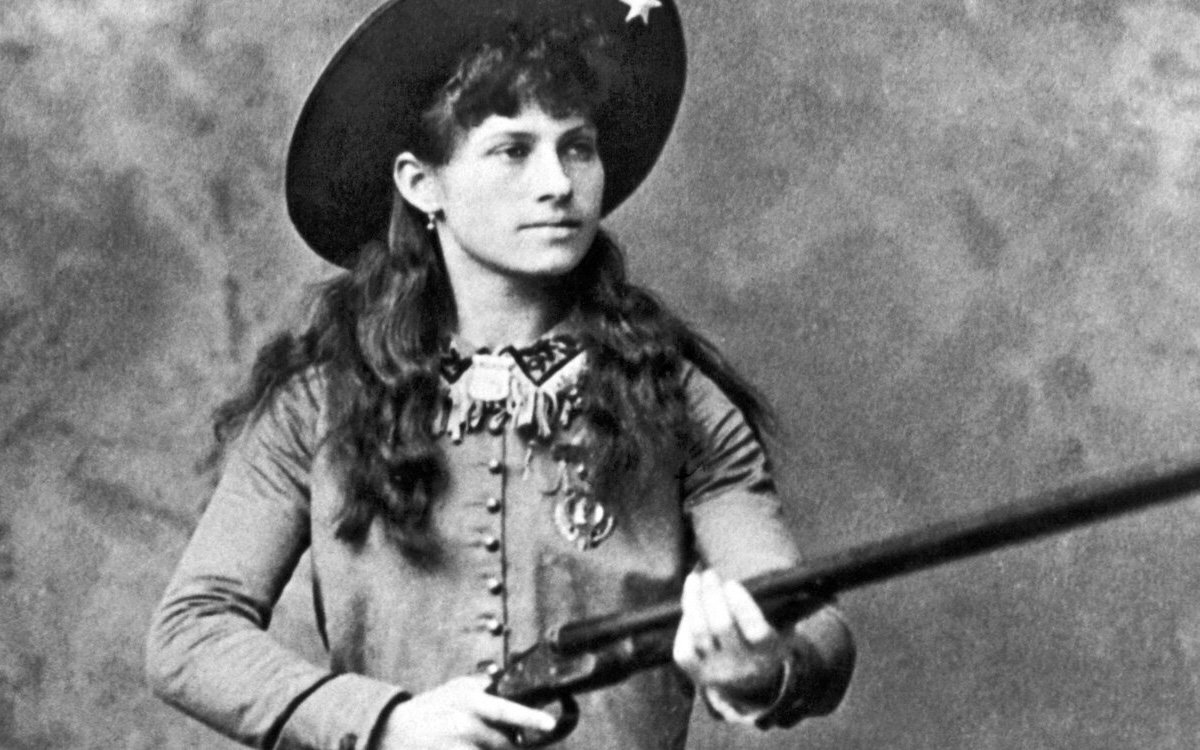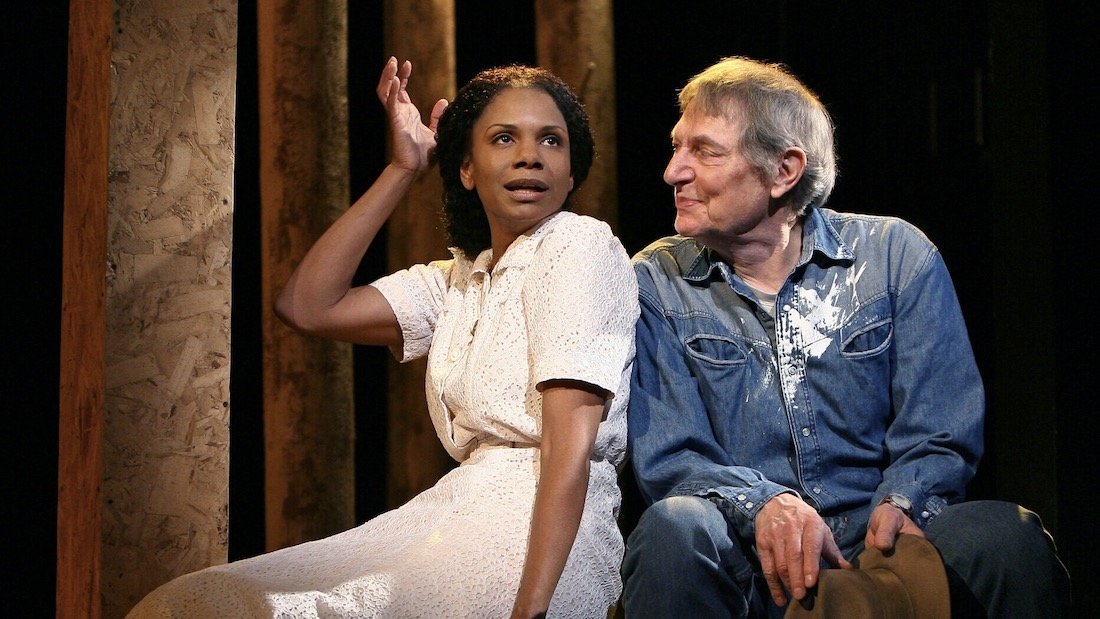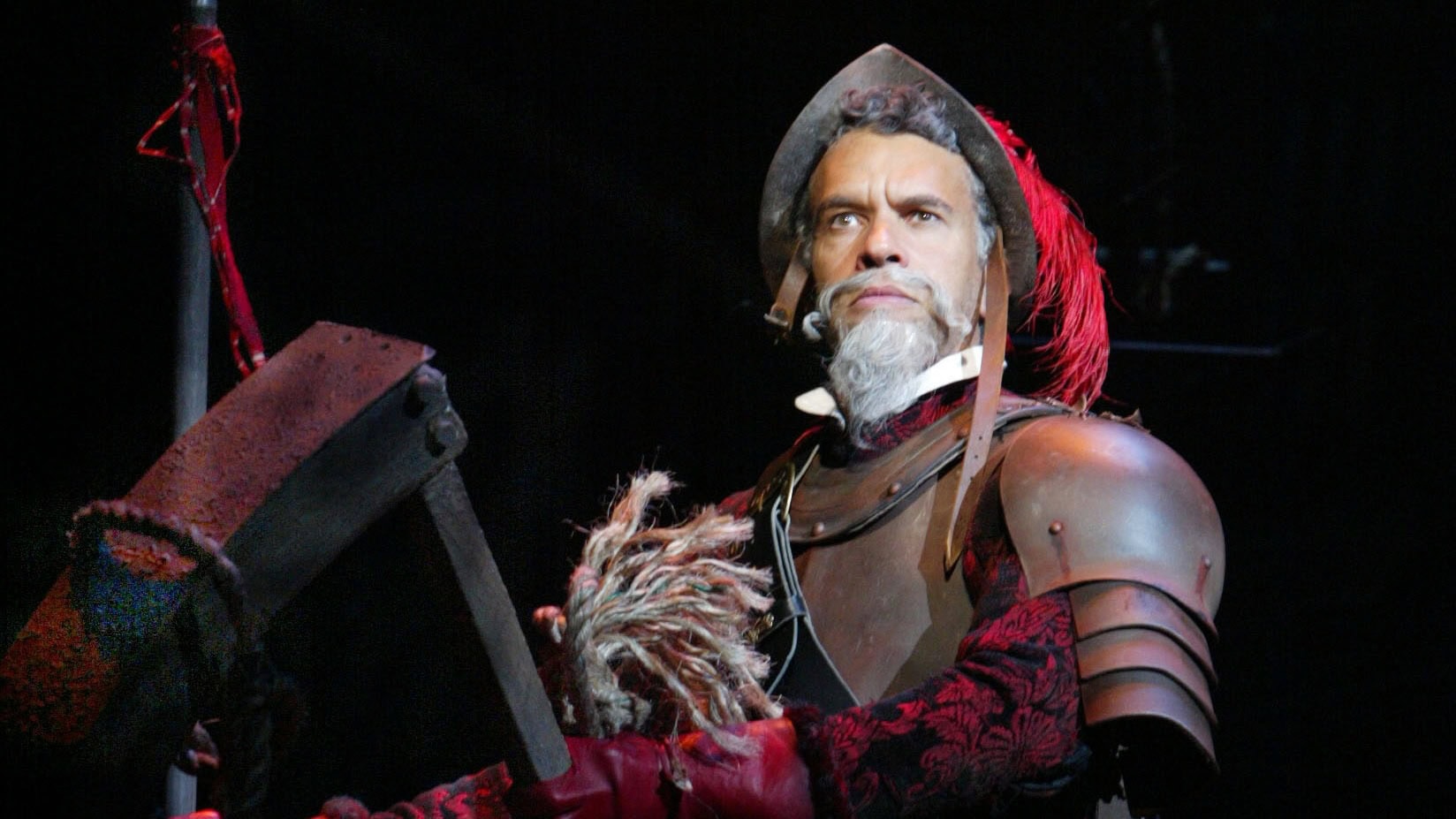
Irving Berlin’s Annie Get Your Gun (US/UK) brought classic Wild West shows to the musical stage by sharing the life story of Annie Oakley, star of Buffalo Bill’s Wild West Show.
But what did the real lives of these skilled and multi-faceted performers entail? Discover the colorful history of the real people behind the characters in Annie Get Your Gun.
Annie Oakley
In the show:
Annie Oakley is a strong-minded, petite young woman, a little rough around the edges, who possesses a gift with a gun. After Annie wins a shooting challenge in her town, Buffalo Bill and the show’s manager, Charlie Davenport, invite her to join their touring Wild West Show. Annie agrees, primarily to be closer to the handsome Frank Butler, whom she had just defeated in the challenge.
Annie’s time at the show is tumultuous, to say the least. Not only does she continue dazzling audiences with her performances, cementing herself as the must-see act of the show, but she also tries to make Frank Butler commit to her, leaving her torn between her career and romantic aspirations.
Frank and Annie do marry at the end of the show, but only after she pretends to lose to him during a shoot-out, saving his pride and ensuring their “happily ever after.”
In real life:
Annie Oakley, born Phoebe Ann Mosey (August 13, 1860 – November 3, 1926), was a sharpshooter from Ohio who rose to fame as part of Buffalo Bill’s Wild West show, which toured not only the US, but the world.
Coming from humble beginnings, Oakley learned to shoot by the age of eight, supporting her widowed mother and many siblings through her skill. By the age of nine she was no longer living at home, having been bound out to, and mistreated by, a family known as “The Wolves,” and later fostered by another, only returning home to her mother at 15 years of age. Upon her return, Annie continued game hunting to support her family, paying off the mortgage on her mother’s farm within the first year of her return.
At this time she won a shooting contest against experienced marksman Frank E. Butler, whom she later married. In 1885 they joined Buffalo Bill’s show, performing for years in the US and Europe before royalty, heads of state and adoring crowds.
With her active show-life behind her, Annie Oakley continued setting records well into her sixties as well as engaging in extensive philanthropy for women’s rights. At the age of 66, she died of pernicious anemia in her home state of Ohio. Her husband, Butler, died a mere 18 days later.
Frank E. Butler
In the show:
Frank Butler is the womanizing and slightly cocky star of Buffalo Bill’s Wild West show.
At first, Frank dazzles young Annie with his sharp-shooting skills and cool demeanor, leaving her smitten. However, unbeknownst to Frank, Annie reappears as his opponent as a small town shoot-out, beating him at his own game and taking the top spot in Bill’s Wild West show.
Though Frank truly grows to love Annie, his feelings tend to be hindered by his own need for success and her ability to outshine him.
In real life:
Francis E. Butler (1847 – November 21, 1926) was an Irish American marksman who performed in many Wild West variety shows, including that of Buffalo Bill, alongside Annie Oakley.
After moving to the United States from County Longford, Ireland, at the age of 13, Butler took on various odd jobs before eventually developing his own shooting act, starting his career as a touring marksman. During this time he married Henrietta Saunders and had two children, though the marriage ended fairly soon after.
During a shooting competition in Cincinnati, Ohio, he came across the young sharpshooter Annie Oakley. They went on to marry in 1876, staying and performing together until Oakley’s death in 1926. It is said that Annie’s death impacted him so much so that, after 18 days, he too passed away due to self-imposed starvation brought on by his grief.
Buffalo Bill Cody
In the show:
Buffalo Bill is the man behind Buffalo Bill’s Wild West show, sharing the eccentricity and skill of the West throughout the world. After many years and a lot of competition, he attempts to merge his show with rival Pawnee Bill’s Far East show, ensuring his show’s survival.
In real life:
William Frederick “Buffalo Bill” Cody (February 26, 1846 – January 10, 1917), though well-known for his variety show, started his professional life as a bison hunter and American soldier.
Soon after his father’s death, Bill started working, becoming a rider for the Pony Express at age 15. During the American Civil War, he served the Union from 1863 to the end of the war in 1865. Later he served as a civilian scout for the US Army during the Indian Wars.
Buffalo Bill received his nickname after the American Civil War, when he had a contract to supply Kansas Pacific Railroad workers with buffalo meat. Bill is purported to have killed 4,282 buffalo in eighteen months in 1867 and 1868.
Buffalo Bill’s legend began to spread; by the time he was 23, he’d become one of the most famous figures of the American Old West. In his mid-twenties, he started performing in shows displaying cowboy themes and episodes from the frontier and Indian Wars. He founded Buffalo Bill’s Wild West in 1883, taking his large company on tours in the United States and, beginning in 1887, in Great Britain and continental Europe.
His fame was so great that he not only co-founded his namesake city of Cody, Wyoming, but he also greatly influenced the world’s perception of what the Wild West was.
Chief Sitting Bull
In the show:
Chief Sitting Bull is presented as a friend of Annie Oakley, giving her crucial advice to not only help her career, but also ensure that she gets the man of her dreams.
In real life:
Chief Sitting Bull (1831 – December 15, 1890), born Jumping Badger, was a Teton Dakota Indian chief who led his people during years of resistance against US government policies.
When he was 14 years old he accompanied a group of Lakota warriors alongside his father and uncle in a raiding party to take horses from a camp of Crow warriors. He displayed great bravery. When he returned to camp, his father conferred his own name, Tȟatȟáŋka Íyotake (approximately meaning “buffalo who set himself to watch over the herd,” simplified to Sitting Bull), upon his son.
Sitting Bull first battled the U.S. Army in June of 1863, when they came after the Santee Sioux (not the Dakota) in retaliation for the Minnesota Uprising, sparked when federal agents withheld food from the Sioux living on reservations along the Minnesota River. He faced the U.S. military again at the Battle of Killdeer Mountain in 1864, when U.S. forces under General Alfred Sully surrounded an Indian trading village, eventually forcing the Sioux to retreat. These face-offs convinced Sitting Bull to never sign a treaty that would force his people onto a reservation.
Sitting Bull’s anti-treaty stance won him many followers, and in 1869 he was made supreme leader of the autonomous bands of Lakota Sioux—the first person to ever hold such a title. His strength and leadership led to success in the Battle of the Rosebud (17 June,1876) and the Battle of Little Bighorn (25 June, 1876).
In the wake of The Battle of Little Bighorn, the incensed U.S. government redoubled their efforts to hunt down the Sioux. This, paired with a reduction in buffalo due to settlers moving onto traditionally Native lands, forced Sitting Bull to lead his people to safety in Canada in 1877. Unfortunately in 1881, due to a scarcity of food and resources in the area, Sitting Bull was eventually forced to surrender in exchange for amnesty for his people, later becoming a prisoner of war in South Dakota’s Fort Randall for two years before being moved to Standing Rock Reservation.
In 1884, during one of his trips outside the reservation, Sitting Bull struck up a friendship with sharpshooter Annie Oakley, whom he affectionately nicknamed “Little Sure Shot” after seeing her perform. Soon after their meeting, in 1885, Chief Sitting Bull became a part of Buffalo Bill’s Wild West show, where he rode once around the arena to the great excitement of audiences. Though his time with the show was short at merely four months, he made his mark on all involved.
Once his time on the show came to an end, Sitting Bull returned to the Standing Rock Agency in South Dakota. Due to fears that he would use his influence to support the Ghost Dance movement, Indian Service agent James McLaughlin at Fort Yates ordered his arrest. During an ensuing struggle between Sitting Bull’s followers and the agency police, Sitting Bull was shot and killed by Standing Rock policemen.
Pawnee Bill
In real life:
Pawnee Bill is the owner of the rival Wild West show named Pawnee Bill’s Far East Show. After a short success, his show starts suffering financially and he hopes that in merging with Buffalo Bill’s Wild West show, that the union will bring him a second chance of success.
In the show:
Gordon William Lillie (February 14, 1860 – February 3, 1942) developed a love for the West after moving to Kansas with his family. From the age of 19 he had started working on the Pawnee Indian agency in Indian Territory, before being given a chance to work as a Pawnee interpreter with Buffalo Bill’s Wild West Show in 1883, hence his nickname of Pawnee Bill.
Three years after joining Buffalo Bill’s show, Pawnee Bill married a young Quaker named May Manning, a graduate and daughter of a wealthy physician. By 1888, they had started their own venture into the world of Wild West shows, to mixed success. Pawnee Bill did go on to work with Buffalo Bill again, in a venture titled the Two Bill’s show, which didn’t fare quite as well as hoped.
Luckily Bill had his fingers in many pies. Throughout his working life he had invested in banking, real estate and oil, and even dabbled in filmmaking at his ranch.
In September 1936, on a drive back to the ranch with his wife late at night, Pawnee Bill lost control of his vehicle; his wife May died as a result of her injuries. Pawnee Bill never fully recovered from the trauma of his wife’s death, and he died a few years later, shortly before his 82nd birthday.
For more information about Annie Get Your Gun, visit Concord Theatricals in the US or UK.

Plays that Inspired Musicals

QUIZ: Which Character from The Lightning Thief Are You?






